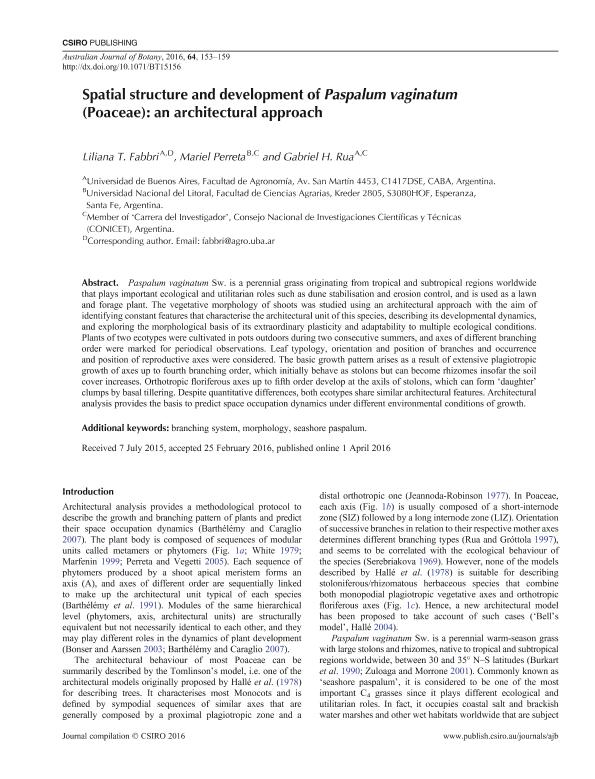Artículo
Spatial structure and development of Paspalum vaginatum (Poaceae): an architectural approach
Fecha de publicación:
03/2016
Editorial:
Csiro Publishing
Revista:
Australian Journal of Botany
ISSN:
0067-1924
e-ISSN:
1444-9862
Idioma:
Inglés
Tipo de recurso:
Artículo publicado
Clasificación temática:
Resumen
Paspalum vaginatum Sw. is a perennial grass from tropical and subtropical regions worldwide, that plays important ecological and utilitarian roles such as dune stabilization and erosion control, and is used as a lawn and forage plant. The vegetative morphology of shoots was studied using an architectural approach with the aim of identifying constant features that characterize the architectural unit of this species, describing its developmental dynamics, and exploring the morphological basis of its extraordinary plasticity and adaptability to multiple ecological conditions. Plants of two ecotypes were cultivated in pots outdoors during two consecutive summers, and axes of different branching order were marked for periodical observations. Leaf typology, orientation and position of branches, and occurrence and position of reproductive axes were considered. The basic growth pattern arises as a result of extensive plagiotropic growth of axes up to fourth branching order, which initially behaves as stolons but can become rhizomes insofar the soil cover increases. Orthotropic floriferous axes up to fifth order develop at the axils of stolons, which can form ´daugther´ clumps by basal tillering. Despite quantitative differences, both ecotypes share similar architectural features. Architectural analysis provides the basis to predict space occupation dynamics under different environmental conditions of growth.
Palabras clave:
Branching System
,
Morphology
,
Seashore Paspalum
Archivos asociados
Licencia
Identificadores
Colecciones
Articulos(OCA PQUE. CENTENARIO)
Articulos de OFICINA DE COORDINACION ADMINISTRATIVA PQUE. CENTENARIO
Articulos de OFICINA DE COORDINACION ADMINISTRATIVA PQUE. CENTENARIO
Citación
Fabbri, Liliana Teresa; Perreta, Mariel Gladis; Rua, Gabriel Hugo; Spatial structure and development of Paspalum vaginatum (Poaceae): an architectural approach; Csiro Publishing; Australian Journal of Botany; 64; 2; 3-2016; 153-159
Compartir
Altmétricas




